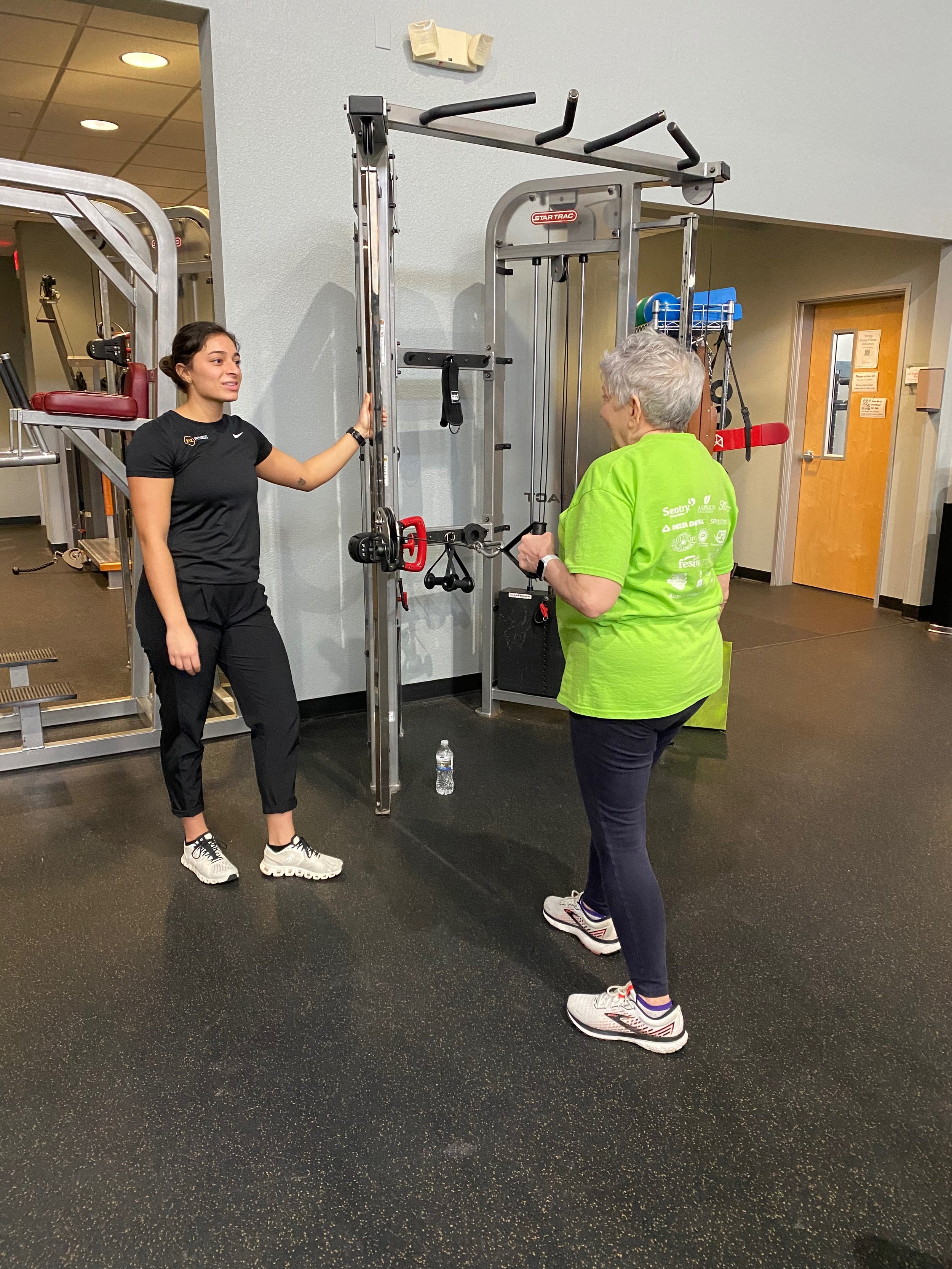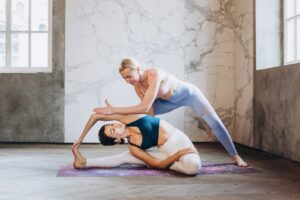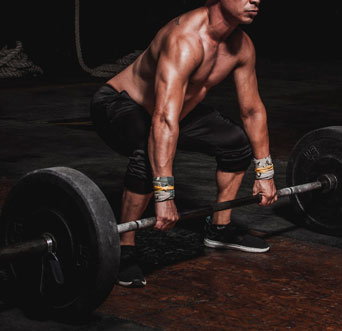Functional fitness improves your ability to perform everyday activities by focusing on movements that mimic real-life tasks. In this type of training, exercises are designed to target multiple muscle groups and train your body to work together in a functional way.
By incorporating functional fitness into your routine, you can enhance your strength, flexibility, coordination, and balance, making it easier to perform tasks like lifting heavy objects, carrying groceries, or getting up from a chair. This type of training is especially beneficial for older adults as it can help maintain independence and prevent falls.
Overall, functional fitness is a practical and effective way to improve your physical capabilities for everyday activities.

Credit: www.212fitnessclub.com
How Functional Fitness Can Improve Everyday Activities
Functional Fitness For Everyday Activities
Functional fitness is a type of exercise that focuses on building strength, balance, flexibility, mobility, coordination, and agility. Unlike traditional workouts that isolate specific muscle groups, functional fitness exercises mimic everyday movements, making them incredibly practical for improving your overall physical abilities.
Whether you’re lifting, bending, reaching, or carrying items, functional fitness can help you perform these activities with ease and reduce the risk of injuries. In this section, we’ll explore three key areas where functional fitness can have a significant impact: enhanced strength and balance, increased flexibility and mobility, and improved coordination and agility.
Enhanced Strength And Balance
- Functional fitness exercises engage multiple muscle groups simultaneously, helping to improve overall strength.
- By focusing on stability and balance, functional fitness workouts can enhance your ability to maintain stability in everyday tasks.
- Building core strength through functional movements can improve posture and decrease the risk of falls or accidents.
- Increased strength and balance can contribute to improved performance in activities such as lifting heavy objects, carrying groceries, or even navigating uneven terrain.
Increased Flexibility And Mobility
- Functional fitness exercises involve movements that promote flexibility and mobility in various joints and muscles in the body.
- Stretching exercises performed during functional fitness routines can help increase range of motion and decrease muscle stiffness.
- Improved flexibility can make everyday activities like bending, reaching, and twisting much easier and less taxing on the body.
- Enhancing mobility can also contribute to reduced joint pain and better overall movement quality.
Improved Coordination And Agility
- Functional fitness workouts challenge coordination and agility by incorporating movements that require balance, timing, and spatial awareness.
- These exercises can improve your ability to perform complex movements, such as climbing stairs, getting in and out of a car, or playing sports.
- The combination of balance, strength, and coordination trained in functional fitness can help prevent injuries caused by falls or accidents.
- Improved agility can also lead to enhanced reaction times and better overall coordination in daily activities that require quick movements.
Incorporating functional fitness into your exercise routine can have a profound impact on your performance and confidence when it comes to everyday activities. By enhancing your strength and balance, increasing your flexibility and mobility, and improving coordination and agility, functional fitness equips you with the physical capabilities to navigate life’s challenges with ease.
So, why not start integrating functional fitness exercises into your workouts today and experience the benefits firsthand?
Incorporating Functional Fitness Into Your Daily Routine
We all lead busy lives, but that doesn’t mean we should neglect our physical well-being. Incorporating functional fitness into your daily routine is a great way to stay active and improve your overall health. By focusing on exercises that mimic everyday activities, you’ll not only become stronger and more flexible, but you’ll also enhance your ability to perform daily tasks with ease.
Let’s explore some simple exercises, tips, and examples of functional fitness exercises that you can easily incorporate into your daily activities.
Simple Exercises To Improve Functional Fitness
- Squats: Squats are a great exercise for building lower body strength and stability. Stand with your feet shoulder-width apart, lower your body by bending your knees until your thighs are parallel to the ground, and then push through your heels to return to the starting position.
- Push-ups: Push-ups are an effective upper body exercise that works your chest, shoulders, and arms. Start in a plank position with your hands slightly wider than shoulder-width apart, lower your chest towards the ground, and then push back up.
- Lunges: Lunges help to strengthen your legs, improve balance, and enhance functional mobility. Take a step forward with one foot, lower your body by bending both knees, and then push through the heel of your front foot to return to the starting position. Repeat with the opposite leg.
- Planks: Planks are a fantastic core exercise that targets your abs, back, and shoulders. Start in a push-up position but rest on your forearms instead of your hands. Keep your body in a straight line from head to heels and hold the position for as long as you can.
Tips For Adding Functional Fitness To Your Daily Activities
- Take the stairs instead of the elevator whenever possible. It’s a simple way to incorporate more movement into your day and engage your leg muscles.
- Use your body weight for resistance during everyday tasks. For example, when carrying groceries, focus on engaging your core muscles and using proper lifting techniques.
- Break up long periods of sitting with short bursts of activity. Set a timer to remind yourself to stand up, stretch, or take a short walk every 30 minutes.
- Be mindful of your posture throughout the day. Practice good alignment by standing tall, pulling your shoulders back, and engaging your core muscles.
Examples Of Functional Fitness Exercises For Everyday Tasks
- Gardening: Squatting to pull weeds, lifting pots, and pushing a wheelbarrow all require strength and mobility.
- Cleaning: Activities like vacuuming, mopping, and scrubbing engage various muscle groups, particularly in your arms, core, and legs.
- Carrying groceries: Instead of taking the easy route and using a cart, challenge yourself by carrying your groceries and engaging your arm and leg muscles.
- Playing with kids: Whether it’s playing catch, chasing them around the park, or lifting them up, playing with your children can be a fun and functional way to exercise.
Incorporating functional fitness into your daily routine doesn’t have to be complicated or time-consuming. By making small changes and being mindful of your movements, you can improve your strength, flexibility, and overall well-being. So, why not start today? Take the stairs, do some squats while waiting for your coffee to brew, and make functional fitness a part of your everyday life.
Functional Fitness For Lifting And Carrying
Whether it’s picking up groceries, moving furniture, or carrying your child, lifting and carrying objects are daily activities that can put a strain on our bodies if not done correctly. Functional fitness exercises and proper lifting techniques can help prevent injuries and make these tasks easier.
In this section, we will explore strengthening exercises for lifting and carrying objects and provide tips on proper lifting techniques to keep you safe and strong.
Strengthening Exercises For Lifting And Carrying Objects
To prepare your body for the physical demands of lifting and carrying objects, incorporating specific strengthening exercises into your fitness routine can make a significant difference. These exercises focus on building strength, stability, and mobility in the muscles and joints involved in lifting and carrying.
Here are some key exercises to consider:
- Squats: Squats are an excellent full-body exercise that targets the muscles in your legs, hips, and lower back. By strengthening these areas, squats help improve your overall lifting and carrying capabilities.
- Deadlifts: Deadlifts are a compound exercise that primarily targets the muscles in your back, glutes, and hamstrings. They mimic the movements required for lifting heavy objects from the ground, making them a valuable exercise for functional fitness.
- Farmer’s carry: The farmer’s carry exercise involves walking while holding weighted objects such as dumbbells or kettlebells in each hand. This exercise not only strengthens your grip but also works your core, back, and shoulder muscles, which are essential for carrying heavy loads.
- Shoulder press: The shoulder press targets the muscles in your shoulders, upper back, and arms. Strengthening these muscles can improve your ability to lift and carry objects overhead, such as placing items on high shelves.
By incorporating these strengthening exercises into your workout routine, you can enhance your overall strength and stability, making lifting and carrying tasks easier and safer.
Proper Lifting Techniques To Prevent Injuries
In addition to strength training, it’s crucial to use proper lifting techniques to avoid injuries when handling heavy objects. Here are some essential tips to keep in mind:
- Maintain a stable base: Stand with your feet shoulder-width apart and one foot slightly in front of the other. This wider stance provides better stability and balance.
- Bend at the knees and hips: When lifting, squat down by bending your knees and hips instead of bending over from your waist. Keep your back straight and avoid rounding your shoulders.
- Use your leg muscles: As you lift, focus on using the power of your leg muscles to push off the floor. This helps minimize strain on your back.
- Keep the load close to your body: When carrying objects, hold them close to your body to reduce the strain on your back. Avoid extending your arms fully, as this can put unnecessary stress on your shoulders and back.
- Avoid twisting or jerking movements: When turning or changing directions while carrying a load, pivot your feet instead of twisting your torso.
By following these proper lifting techniques, you can minimize the risk of injury and protect your body when lifting and carrying objects in your daily life.
Remember, functional fitness is not only about looking strong but also about being strong and capable in real-life situations. Incorporating strengthening exercises for lifting and carrying objects into your fitness routine and using proper lifting techniques can help you maintain a healthy and injury-free lifestyle.
Functional Fitness For Balance And Stability
Having good balance and stability is essential for performing everyday activities with ease and confidence. Whether you’re walking down the street, climbing stairs, or even just standing up from a chair, balance and stability play a crucial role in maintaining your overall mobility and preventing falls.
In this section, we will explore exercises to improve balance and stability and the benefits of good balance for everyday activities.
Exercises To Improve Balance And Stability
Improving your balance and stability doesn’t have to be complicated or time-consuming. By incorporating a few simple exercises into your routine, you can enhance your overall ability to stay steady on your feet, react to sudden movements, and maintain better body control.
Here are some exercises that can help:
- Single-leg stance: Stand on one leg while maintaining your balance for 30 seconds. Repeat on the other leg. This exercise helps to strengthen the muscles in your legs and improve balance.
- Heel-to-toe walk: Place your right heel in front of your left toes and walk in a straight line. This exercise promotes better coordination and balance.
- Side leg raises: Stand tall and slowly lift one leg out to the side, then lower it back down. Repeat on the other side. This exercise targets the muscles in the hips, thighs, and glutes, improving stability and balance.
- Yoga tree pose: Stand with your feet together and shift your weight onto one foot. Place the sole of your other foot against your inner thigh or calf, avoiding contact with your knee. Hold for 30 seconds, then switch sides. This pose challenges your balance and strengthens your core and leg muscles.
Benefits Of Good Balance For Everyday Activities
Having good balance and stability goes beyond just preventing falls. It can significantly enhance your performance in various everyday activities. Here are some benefits of good balance:
- Injury prevention: Good balance helps you maintain stability and react quickly to prevent injuries from slips, trips, and falls.
- Improved posture: By improving your balance, you also improve your posture. Good posture contributes to better alignment and reduces strain on your muscles and joints.
- Enhanced agility: When your balance is on point, you can move more efficiently and with greater ease, making activities like walking, running, and climbing stairs feel effortless.
- Increased confidence: Being confident in your ability to maintain your balance boosts your overall confidence and makes you more comfortable in performing everyday activities.
Remember, achieving and maintaining good balance and stability takes practice. Start by incorporating these exercises into your weekly routine, and you’ll soon notice improvements in your ability to stay steady and confident in your everyday activities.
Functional Fitness For Joint Health And Mobility
As we go about our daily lives, we often take for granted the ability to perform simple movements like bending down to tie our shoes or reaching up to grab something from a high shelf. It’s not until we experience joint pain or limited mobility that we realize the importance of keeping our joints healthy and mobile.
That’s where functional fitness comes in. By incorporating exercises specifically designed to promote joint flexibility and mobility into our fitness routines, we can enhance our overall quality of life and ensure that we can continue to perform everyday activities with ease.
In this section, we will explore the exercises to promote joint flexibility and mobility and discuss the significance of joint health for everyday movements.
Exercises To Promote Joint Flexibility And Mobility:
- Yoga: Engaging in regular yoga practice can help improve joint flexibility and mobility. Poses like downward dog, cat-cow, and child’s pose target multiple joints, promoting their proper alignment and increasing range of motion.
- Joint mobilization exercises: These exercises involve moving a joint through its full range of motion to increase flexibility and reduce stiffness. Examples include shoulder circles, ankle rolls, and wrist circles.
- Resistance band exercises: Utilizing resistance bands can provide gentle yet effective resistance to joints, promoting flexibility and stability. Exercises such as band shoulder rotations, leg abductions, and bicep curls can help improve joint health.
- Tai chi: Practicing tai chi involves slow and controlled movements that focus on balance, coordination, and joint mobility. This traditional chinese martial art is particularly beneficial for older adults looking to improve joint health.
Importance Of Joint Health For Everyday Movements:
- Proper joint function is crucial for performing everyday activities such as walking, standing, and sitting down. When our joints are healthy and mobile, we can move smoothly and effortlessly.
- Maintaining good joint health helps prevent injuries and reduces the risk of developing chronic conditions such as arthritis. By keeping our joints flexible and strong, we can minimize pain and discomfort.
- Healthy joints contribute to better posture and alignment, which can improve overall body mechanics. Good posture reduces stress on joints, preventing unnecessary wear and tear.
- Joint flexibility and mobility enable us to maintain an active lifestyle as we age. By prioritizing joint health, we can continue to participate in activities we love, such as gardening, dancing, or playing sports.
Incorporating functional fitness exercises that target joint flexibility and mobility into our fitness routines is essential for ensuring optimal joint health. By taking care of our joints, we can enhance our ability to perform everyday movements with ease and maintain an active and fulfilling lifestyle.
So, let’s prioritize our joint health and start reaping the benefits of functional fitness today!
The Role Of Functional Fitness In Maintaining Independence
Functional Fitness For Everyday Activities
Functional fitness plays a crucial role in maintaining independence, especially for older adults. By focusing on exercises that mimic real-life movements, functional fitness helps individuals improve their strength, flexibility, balance, and coordination, enabling them to perform everyday activities with ease and reduce the risk of falls and injuries.
Let’s explore the benefits of functional fitness for older adults and how it can help prevent falls and injuries.
Benefits Of Functional Fitness For Older Adults
Functional fitness offers numerous benefits for older adults, allowing them to enhance their overall well-being and maintain an active and independent lifestyle. Here are some key benefits:
- Improved strength: Functional exercises engage multiple muscle groups, helping to increase strength and mobility. This enhanced strength makes it easier for older adults to perform daily tasks such as lifting groceries, climbing stairs, or getting up from a chair.
- Enhanced flexibility: Many functional fitness exercises involve stretching movements that can improve flexibility and range of motion. This increased flexibility allows older adults to perform movements with more ease and reduces the risk of strain or injury.
- Better balance and coordination: Functional fitness exercises often focus on stability and coordination, which are crucial for maintaining balance and preventing falls. By working on these areas, older adults can reduce the likelihood of accidents and maintain their independence.
- Weight management: Regular functional fitness workouts help older adults maintain a healthy weight. By engaging in activities that burn calories and build muscle, individuals can manage their weight and reduce the risk of chronic conditions associated with obesity.
- Increased energy levels: Engaging in functional fitness activities can lead to increased energy levels and a higher overall sense of well-being. Regular exercise releases endorphins, which promote feelings of positivity and reduce stress levels.
How Functional Fitness Can Help Prevent Falls And Injuries
Falls and injuries are a major concern for older adults, often leading to a loss of independence and a decrease in overall quality of life. Functional fitness can significantly reduce the risk of falls and injuries by addressing specific areas of concern.
Here’s how functional fitness can help:
- Improved balance: Functional exercises that focus on stability and balance can help older adults develop a stronger core and better posture. These exercises challenge the body’s balance systems and help individuals maintain their balance, reducing the risk of falls.
- Increased strength: By targeting specific muscle groups used in daily activities, functional fitness exercises can enhance overall strength. Stronger muscles offer better support to joints, reducing the risk of injury during tasks like lifting objects or walking on uneven surfaces.
- Enhanced reflexes and coordination: Functional exercises that improve reflexes and coordination allow individuals to react quickly and adapt to sudden changes in their environment. This increased agility can help older adults avoid accidents and prevent falls.
- Improved bone density: Weight-bearing activities, such as functional exercises that involve resistance training, help improve bone density and reduce the risk of osteoporosis. Stronger bones are less likely to fracture during a fall, further preventing injuries.
- Increased confidence: Engaging in functional fitness activities and witnessing improvements in strength, balance, and coordination can boost an older adult’s confidence. Increased confidence leads to better overall mobility and a reduced fear of falling.
Functional fitness plays a vital role in maintaining independence for older adults. By reaping the benefits of improved strength, flexibility, balance, and coordination, individuals can perform everyday activities with ease and reduce the risk of falls and injuries. Incorporating functional fitness into a regular exercise routine will greatly contribute to maintaining a healthy and fulfilling lifestyle.
So, prioritize functional fitness and embrace the benefits it offers for a more independent and active future.
Exercises For Functional Fitness In Older Adults
Functional fitness is a crucial aspect of maintaining a healthy and active lifestyle, especially for older adults. Engaging in exercises that improve strength and flexibility can greatly enhance everyday activities and promote overall well-being. In this section, we will explore low-impact exercises to enhance strength and flexibility, as well as modifications for individuals with limited mobility.
Low-Impact Exercises To Improve Strength And Flexibility
- Walking: One of the simplest yet effective exercises, walking helps to strengthen the leg muscles and improve cardiovascular health. Aim for at least 30 minutes of brisk walking each day.
- Water aerobics: Exercising in water provides resistance without putting stress on the joints. Water aerobics classes are designed to enhance muscle strength, flexibility, and cardiovascular endurance.
- Yoga: Incorporating gentle yoga poses can improve flexibility, balance, and core strength. Yoga also promotes relaxation and reduces stress levels.
- Resistance band exercises: Using resistance bands can provide low-impact resistance training to strengthen the muscles. They are portable, versatile, and suitable for people of all fitness levels.
- Tai chi: This ancient chinese martial art focuses on slow, flowing movements that improve balance, flexibility, and strength. Tai chi also helps to reduce the risk of falls in older adults.
Modifications For Individuals With Limited Mobility
- Chair exercises: For individuals with limited mobility, exercises performed while sitting on a chair can provide significant benefits. Examples include seated leg lifts, shoulder rolls, and bicep curls using hand weights.
- Seated yoga or stretching: Many yoga poses and stretching exercises can be adapted to a seated position. These exercises can improve range of motion, flexibility, and circulation.
- Resistance band exercises: Individuals with limited mobility can use resistance bands while sitting or lying down to strengthen various muscle groups. Consult with a fitness professional for appropriate modifications.
- Water exercises: Aquatic exercises, such as water walking or gentle water aerobics, allow individuals with limited mobility to exercise in a buoyant and supportive environment.
- Balance exercises: Balance exercises can be modified to suit individuals with limited mobility by using a chair, countertop, or wall for support. These exercises help improve stability and reduce the risk of falls.
Remember to consult with a healthcare professional or certified trainer before starting any new exercise program. By integrating these low-impact exercises and modifications into a fitness routine, older adults can enhance their functional fitness, stay active, and enjoy a better quality of life.
Tips For Staying Motivated With Functional Fitness
Functional Fitness For Everyday Activities
Maintaining a consistent fitness routine can be challenging, especially when life gets busy. However, incorporating functional fitness into your daily life can help you stay motivated and focused on achieving your fitness goals. Here are some tips to help you stay motivated with functional fitness:
Setting Realistic Goals And Tracking Progress
Setting realistic goals is essential when it comes to staying motivated with functional fitness. Here are some key points to consider:
- Identify your priorities: Determine what aspects of your daily life you want to improve through functional fitness. Whether it’s carrying groceries, playing with your kids, or simply having more energy, understanding your priorities will help you set achievable goals.
- Start small: It’s important to start with manageable goals that you can easily incorporate into your routine. Break down your larger fitness goals into smaller, more attainable milestones that you can celebrate along the way.
- Track your progress: Tracking your progress is a great way to stay motivated and see how far you’ve come. Consider using a fitness app or journal to record your workouts, measurements, and any improvements you notice in your everyday activities.
Incorporating Functional Fitness Into A Social Setting
Building a supportive community around your functional fitness journey can provide the motivation and accountability you need. Here’s how you can incorporate functional fitness into a social setting:
- Find a workout buddy: Exercising with a friend or family member can make your workouts more enjoyable and help you stay motivated. Look for someone who shares your fitness goals and can challenge and encourage you along the way.
- Join a group fitness class: Group fitness classes not only offer expert guidance but also provide an opportunity to meet like-minded individuals. Whether it’s a boot camp, cross-training class, or even a recreational sports league, being part of a group can keep you motivated and give you a sense of belonging.
- Participate in challenges or competitions: Engaging in friendly challenges or competitions can add an element of fun and excitement to your functional fitness journey. Consider signing up for a charity run, obstacle course race, or fitness challenge within your community or workplace.
By setting realistic goals, tracking your progress, and incorporating functional fitness into a social setting, you can stay motivated and committed to your fitness journey. Remember, consistency is key, and every small step you take towards a healthier and fitter lifestyle counts.
So, lace up your sneakers, gather your workout buddies, and get ready to embrace functional fitness for everyday activities.
Frequently Asked Questions Of Functional Fitness For Everyday Activities
What Is Functional Fitness?
Functional fitness is a type of exercise that focuses on building strength, endurance, and flexibility to improve everyday activities. It includes exercises that mimic movements we use in daily life, such as squatting, lifting, and twisting. It helps improve balance, stability, and overall fitness level.
What Are The Benefits Of Functional Fitness?
Functional fitness offers a range of benefits, including improved strength, balance, and flexibility. It helps prevent injuries by training the body to handle real-life movements. It also enhances daily activities, such as carrying groceries or playing with kids. Plus, functional fitness improves overall fitness and boosts metabolism.
How Can Functional Fitness Improve Daily Activities?
By engaging in functional fitness exercises, you can improve your strength, endurance, and flexibility, making daily activities easier and more manageable. Functional fitness helps with tasks like lifting heavy objects, climbing stairs, and bending. It also enhances balance and stability, reducing the risk of falls and injury.
Can Functional Fitness Help With Weight Loss?
Yes, functional fitness can aid in weight loss. By engaging in these exercises, you increase your heart rate, burn calories, and boost metabolism. Additionally, functional fitness helps build lean muscle mass, which helps increase calorie burn throughout the day. When combined with a healthy diet, it can be an effective tool for weight loss.
Is Functional Fitness Suitable For All Fitness Levels?
Yes, functional fitness is suitable for all fitness levels. Modifications can be made to exercises to accommodate beginners or those with physical limitations. Whether you’re a beginner or an advanced athlete, functional fitness can be personalized to meet your needs and goals.
It’s important to start gradually and consult a fitness professional if needed.
Conclusion
Functional fitness is a key component in maintaining overall health and well-being. By focusing on exercises that mimic everyday activities, we can improve our strength, flexibility, balance, and coordination, making it easier to perform daily tasks with ease and confidence.
Whether it’s lifting groceries, climbing stairs, or playing with our kids, functional fitness helps us stay active, independent, and injury-free. Regular functional fitness training also offers numerous other benefits. It can increase our energy levels, boost our mood, and enhance our cognitive function.
Not to mention, it can significantly improve our posture and body alignment, reducing the risk of developing chronic pain or injuries in the long run. Incorporating functional fitness into our daily routines doesn’t have to be complicated or time-consuming. Simple exercises like squats, lunges, planks, and walking can make a world of difference.
So, let’s prioritize our functional fitness and start reaping the rewards of a healthier, more active lifestyle. Your body and mind will thank you for it.




